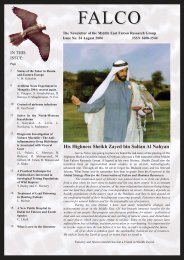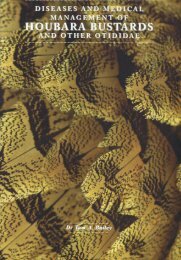Captive breeding and reintroduction of Arabian mountain and
Captive breeding and reintroduction of Arabian mountain and
Captive breeding and reintroduction of Arabian mountain and
Create successful ePaper yourself
Turn your PDF publications into a flip-book with our unique Google optimized e-Paper software.
Release <strong>of</strong> Reem gazelles in Mahazat as Sayd<br />
Mahazat as Sayd lies 150 km northeast <strong>of</strong> Taif in western Saudi Arabia. It is a fenced reserve covering<br />
an area <strong>of</strong> 2244 km 2 <strong>of</strong> open desert steppe habitat (Child <strong>and</strong> Grainger, 1990). The topography <strong>of</strong> the<br />
area is gentle with elevations ranging from 900 -1100 m above sea level depending on whether it is in<br />
wadis or basalt relief. The majority <strong>of</strong> the reserve area (96%) is covered with s<strong>and</strong> including gravel. It<br />
was declared a protected area in 1988 as a primary site for <strong>reintroduction</strong> <strong>of</strong> the <strong>Arabian</strong> Oryx (Oryx<br />
leucoryx), Houbara bustard (Chlamydotis undulate macqueeni) <strong>and</strong> ostrich (Struthio camelus). Mountain<br />
gazelles <strong>and</strong> the Afri gazelle were probably the principle resident species in this area, although S<strong>and</strong><br />
gazelles were also recorded (Vesey-Fitzgerald, 1952). The <strong>Arabian</strong> Oryx was reintroduced into the<br />
reserve during 1989 <strong>and</strong> the <strong>Arabian</strong> s<strong>and</strong> gazelle (Gazella subgutturosa marica) was reintroduced into<br />
the area during 1990. A total <strong>of</strong> 135 (58.77) Reem gazelles were transported to the reserve during 1990<br />
(Haque <strong>and</strong> Smith, 1996). They were kept in pre release pens for a period <strong>of</strong> 2–3 months where they<br />
were vaccinated, tagged, bled for disease screening <strong>and</strong> fitted with radiotransmitters for radiotracking.<br />
Follow up studies have shown that this population increased to a peak <strong>of</strong> some 2000 gazelles by 1999<br />
before experiencing losses. It is currently believed to be stable or increasing.<br />
Release <strong>of</strong> Reem <strong>and</strong> Idmi gazelles in Uruq Bani Ma’arid<br />
Uruq Bani Ma’arid (18° 30' – 20° N 45° – 46° 15' E) is located in the western edge <strong>of</strong> the Empty Quarter<br />
desert (Child <strong>and</strong> Grainger, 1990; Abu Elzein et al., 1998). It is entirely unfenced, covering an area <strong>of</strong><br />
12000 km 2 mixed use areas, with a central core zone <strong>of</strong> 2200 km 2 sector defined as a strict wildlife<br />
reserve. During 1995 -1996 groups <strong>of</strong> 205 Reem <strong>and</strong> 72 Idmi gazelles were transported to the protected<br />
area in order to be released there. Gazelles were selected carefully as outlined above. At this site five<br />
prerelease pens were constructed at three different locations within the core area <strong>of</strong> the reserve, allowing<br />
successive release <strong>of</strong> social units, numbering 10-20 animals each, following periods <strong>of</strong> 4-6 weeks<br />
acclimatisation with food <strong>and</strong> water provided before release into the wild. Post-release monitoring <strong>of</strong><br />
S<strong>and</strong> <strong>and</strong> Mountain gazelles at Uruq Bani Ma’arid has relied on both radio-collaring (c. 20% <strong>of</strong><br />
individuals) <strong>and</strong> individual indentification collars on all other released gazelles (wild born gazelles from<br />
these projects remain untagged). The survival <strong>and</strong> the dispersal <strong>of</strong> gazelles in the protected area <strong>and</strong><br />
their acclimatisation to the new environment has been recorded showing that the numbers <strong>and</strong><br />
dispersion <strong>of</strong> both species have increased substantially since <strong>reintroduction</strong>. Importantly it has also<br />
become clear that ecological differences between the two species predicted from the known behaviour <strong>of</strong><br />
remnant wild stocks <strong>of</strong> these species have clearly been preserved to re-emerge in released populations<br />
derived from captive founders. This information constitutes a valuable experience for any future<br />
<strong>reintroduction</strong> programmes.<br />
References<br />
Abu Elzein, E.M.E., S<strong>and</strong>ouka, M.A., Al-Afaleq, A.I., Mohammed, O.B. <strong>and</strong> Flam<strong>and</strong>, J.R.B. (1998): Arbovirus infections <strong>of</strong><br />
ruminants in Al-Rub Al-Khali desert. Veterinary Record 142: 196-197.<br />
Child, G. <strong>and</strong> Grainger, J. (1990): A system plan for protected areas for wildlife conservation <strong>and</strong> sustainable rural development in<br />
Saudi Arabia. NCWCD Riyadh <strong>and</strong> IUCN, Gl<strong>and</strong>. 335 pp.<br />
Dunham, K.M. (1997): Population growth <strong>of</strong> Mountain gazelles Gazella gazella reintroduced to central Arabia. Biological<br />
Conservation 81: 205-214.<br />
Dunham, K.M., Kichenside, T.B., Lindsay, N.B., Rietkerk, F.E. <strong>and</strong> Williamson, D.T. (1993): The <strong>reintroduction</strong> <strong>of</strong> Mountain Gazelle<br />
Gazella gazella in Saudi Arabia. The International Zoo Yearbook 32: 107-116.<br />
Dunham, K. (2001): Status <strong>of</strong> a reintroduced population <strong>of</strong> <strong>mountain</strong> gazelles Gazella gazella in central Arabia: management<br />
lessons from an aridl<strong>and</strong> <strong>reintroduction</strong>. Oryx 35: 111-118.<br />
Greth, A., Magin, C. <strong>and</strong> Ancrenaz, M. (Editors) (1996): Conservation <strong>of</strong> <strong>Arabian</strong> Gazelles. Proceedings <strong>of</strong> the Symposium<br />
“Establishing Priorities for Gazelle Conservation in the <strong>Arabian</strong> Peninsula”, held at the National Commission for Wildlife<br />
Conservation <strong>and</strong> Development (NCWCD) in Riyadh, Saudi Arabia, 31 October – 3 November 1992. pp. 168<br />
Habibi, K. (1994): The Desert Ibex . Immel Publishing, London.<br />
Hammond, R.L., Macasero, W., Flores, B., Mohammed, O.B., Wacher, T. <strong>and</strong> Bruford, M. (2001): Phylogenetic reanalysis <strong>of</strong> the<br />
Saudi Gazelle <strong>and</strong> its implications for conservation. Conservation Biology 15: 1-11.<br />
Haque, M.N. <strong>and</strong> Smith, T.R. (1996): Reintroduction <strong>of</strong> <strong>Arabian</strong> s<strong>and</strong> gazelle Gazella subgutturosa marica in Saudi Arabia.<br />
Biological Conservation 76: 203-207.<br />
IUCN (1995): IUCN/SSC Guidelines For Re-Introductions. Prepared by the SSC Re-introduction Specialist Group. Approved by the<br />
41st Meeting <strong>of</strong> the IUCN Council, Gl<strong>and</strong> Switzerl<strong>and</strong>, May 1995 [ http://iucn.org/themes/ssc/pubs/policy/reintr.htm]<br />
Kichenside, T.B. <strong>and</strong> Lindsay, N.B. (1997): The Husb<strong>and</strong>ry <strong>of</strong> Gazelles at King Khalid Wildlife Research Centre. In: The Gazelles <strong>of</strong><br />
Arabia. (Edited by Habibi, K., Abuzinada, A.H. <strong>and</strong> Nader, I.A.) NCWCD, Riyadh, Publication No 29. Pp 219-230.<br />
Mohammed, O.B. <strong>and</strong> Flam<strong>and</strong>, J.R.B. (1996): Experimental infection <strong>of</strong> <strong>Arabian</strong> s<strong>and</strong> gazelle, Gazella subgutturosa marica with<br />
Eimeria rheemi. Journal <strong>of</strong> Parasitology 82: 356-357.<br />
Mohammed, O.B. <strong>and</strong> Hussein, H.S. (1994): Antibody prevalence <strong>of</strong> tox oplasmosis in <strong>Arabian</strong> gazelles <strong>and</strong> oryx in Saudi Arabia.<br />
Journal <strong>of</strong> Wildlife Diseases 30: 560-562.<br />
Rietkerk, F.E., Griffin, J.F.T., Wood, B., Mubarak, S., Delima, E., Mohammed. O.B., Lindsay, N. <strong>and</strong> Williamson, D.T. (1993):<br />
Treatment <strong>of</strong> bovine tuberculosis in an <strong>Arabian</strong> oryx. Journal <strong>of</strong> Zoo <strong>and</strong> Wildlife Medicine 24: 523-527.<br />
Vassey -Fitgerald, L.D.E.F. (1952): Wildlife in Arabia. Oryx 1: 232-235.<br />
Wacher, T.W <strong>and</strong> Kichenside T.B. (1998): Reintroducting the s<strong>and</strong> gazelle Gazella subgutturosa marica to Urug Bani Ma’arid<br />
Protected Area: Empty Quarter <strong>of</strong> Saudi Arabia. Reintroduction News 15: 10-12.<br />
14




